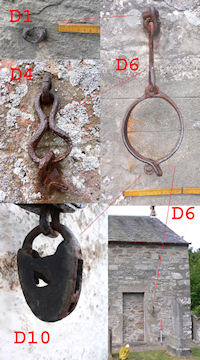
Figure 16: Examples of jougs and components surviving at different sites. D1: Kirkintilloch, Lanarkshire; D4: Blackmount, Peeblesshire; D6: Dowally, Perthshire; D10: Oxnam, Scottish Borders.

Figure 16: Examples of jougs and components surviving at different sites. D1: Kirkintilloch, Lanarkshire; D4: Blackmount, Peeblesshire; D6: Dowally, Perthshire; D10: Oxnam, Scottish Borders.
Best described as an iron collar, the joug is a heavy ring of metal fastened around the neck by a padlock (Fig. 16). There is evidence of jougs on at least twenty churches today (Fig. 17). Typically attached to the church exterior, either by the door or on the same wall in a more visible spot, the average height is approximately 1.65m, though this can vary substantially. Their chains are long enough to accommodate a range of heights, which normally easily allows for wearers of average early modern stature (female: 5'2", male: 5'7". Roberts and Cox 2003, 308), but do not allow for any movement away from the wall. This was tested by subjects of 5'3", 5'7" and 5'11 at several sites (Fig. 18). An important element in interpreting the experience of jougs was analysing how their positioning related to the wider landscape. In rural contexts where modern urbanisation was not an issue, attention was paid to inter-visibility between jougs and possible approaches (Fig. 19). Environmental factors stimulating the senses such as weather and sounds were also considered.

Figure 19: Experimental wear of jougs at Dowally, Perthshire (D6), and Sorn, Ayrshire (D12). Museum specimens were found to weigh up to 1.2kg.
A sinner could be sentenced to two hours in the jougs before the church service, even in the middle of winter (Graham 1996; Todd 2002, 142). Based on experimental wear, penitents would have found them arduous and heavy by part-way through the punishment, even in clement weather. In tests this produced an ache in the shoulders and neck which persisted throughout the day. Experimental archaeology demonstrated that on a sunny day two hours in the jougs could also be enough for the effects of dehydration to be felt. As with the other artefacts, however, jougs had non-physical qualities extending beyond their capacity to keep the penitent static and uncomfortable in a public place.
Jougs, from the French joug and Latin yugum (yoke), are a type of yoke (Simpson and Weiner 1989, 278). In the Old Testament sins are often referred to as an 'iron yoke' or 'yoke upon the neck'. Ministers preaching on the perils of sin could well have expounded upon this connection. Wearing jougs could have been experienced as wearing a material manifestation of sin for all to see, based on a literal interpretation of Biblical texts such as Lamentations 1 and Deuteronomy 28:
'The yoke of my transgressions is bound by his hand: they are wreathed, and come up upon my neck...' (Lamentations 1).
'Because thou servedst not the LORD thy God with joyfulness...shall put a yoke of iron upon thy neck, until he have destroyed thee' (Deuteronomy 28).
Furthermore, the Bible warns against being yoked with unbelievers: 'Be ye not unequally yoked together with unbelievers: for what fellowship hath righteousness with unrighteousness? and what communion hath light with darkness?' (2 Corinthians 6).
The penitent forced to wear the jougs would become part of the artefact's history, one of a fellowship of 'wicked' past wearers. In parishes like Dundonald, with an average of 77 cases per year by 1605 and a population below 1000, few would escape being metaphorically yoked to their fellow sinners over the course of a lifetime (Graham 1996, 253). To Early Modern Scots, far more familiar than we are today with animal management, the yoke could also consciously or subconsciously signify dehumanised or animal status. Alternatively, or perhaps simultaneously, they may have served as machinery for domesticating sin, an interpretation bolstered by the fact that the word joug has also come to be used for animal yokes, such as the bull jougs currently displayed in the Marischal Museum's collections, Aberdeen. (ABDUA 15908).
During research it was discovered jougs endure in both ecclesiastical and civil contexts. Only examples associated with churches are considered here as their widespread use coincided with the Reformation, suggesting an origin fuelled by religious change (Graham 1996; Todd 2002). Researching the Royal Commission on the Ancient and Historical Monuments of Scotland (RCAHMS) database, it became evident that jougs had often been moved from old to new churches, with some even entirely replaced in the 19th century, after a prolonged absence. To establish whether these could be meaningful incorporated into the study, potential artefact biographies were considered in some depth to determine whether remaining examples could be considered to represent 16th- and 17th-century artefacts.
There are numerous accounts of community members remembering their use in the late 18th century, and of old jougs surviving in the Statistical Accounts and New Statistical Accounts (available from http://edina.ac.uk/stat-acc-scot/). Not long after the New Accounts were written many jougs were replaced. It is, therefore, considered that, through local memory assisted by extant examples, sufficient knowledge survived of joug design and positioning that examples today can be considered representative of 16th- and 17th-century artefacts. Relative consistency of style and location is further supported by artefacts of known date and provenance held in museum collections, as well as extant architectural evidence (Fig. 20).

Figure 20: Extant evidence showing where the jougs were once attached to the south-facing wall of Fowlis Easter Parish kirk
Choose your own | Branks | Sackcloth | A Changing World
© Internet Archaeology/Author(s)
University of York legal statements | Terms and Conditions
| File last updated: Thu May 26 2011